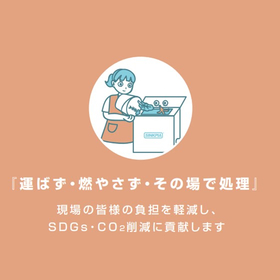Large ingredients are crushed into smaller pieces with a crusher before being added! Mainly processing leafy vegetables generated during the pickling production process.
We would like to introduce a case study regarding the installation of the commercial food waste processor "Sink Pia GJ-250" at Nojima Food Co., Ltd. The main focus is on processing leafy vegetables generated during the pickling manufacturing process. Larger food items are crushed into smaller pieces before being fed into the machine. As a result, it has become easier for microorganisms to process the waste, increasing the efficiency of biodegradation, and the processing is proceeding smoothly. We can also provide optional suggestions, so please feel free to contact us. 【Case Overview】 ■ Mainly processes leafy vegetables generated during the pickling manufacturing process ■ Larger food items are crushed into smaller pieces before being fed into the machine ■ It has become easier for microorganisms to process the waste, increasing the efficiency of biodegradation and processing is proceeding smoothly *For more details, please download the PDF or feel free to contact us.
Inquire About This Product
basic information
For more details, please download the PDF or feel free to contact us.
Price range
Delivery Time
Applications/Examples of results
For more details, please download the PDF or feel free to contact us.
catalog(4)
Download All CatalogsCompany information
"What we want you to discard is the conventional wisdom of food waste disposal machines." The development concept of Sink Pia is to process food waste 'without transporting, without burning, and on-site.' By self-processing food waste within facilities, it contributes to CO2 reduction and the SDGs. Japan's food waste disposal, which has relied heavily on incineration, is at a turning point, and many companies are entering the food waste processing machine industry to meet the needs of the times. However, it is also an industry where many companies have been forced to withdraw due to issues related to research and development costs, as well as a lack of knowledge, experience, and skills. Some have already started demonstration experiments, focusing on the development of microbial houses using biodegradable materials, the development of devices for processing dirty biodegradable containers, and further research on resource recovery such as liquid fertilizers and soil conditioners from decomposed water. We aim to be a company that is needed by more customers and can realize a society that is friendly to the future of the Earth's environment.


![[Comprehensive Catalog] Commercial Food Waste Processor Sink Pia](https://image.mono.ipros.com/public/catalog/image/01/e15/355232/IPROS741825587306973971.jpeg?w=120&h=170)
![[Concept Catalog] Commercial Food Waste Processor Sink Pia](https://image.mono.ipros.com/public/catalog/image/01/9fc/355233/IPROS97919348904398666138.jpeg?w=120&h=170)

![[SINKPIA + SDGs] Commercial Food Waste Processor Sinkpia](https://image.mono.ipros.com/public/catalog/image/01/cd6/665665/IPROS41795439056302394625.jpeg?w=120&h=170)

![[CO2 Reduction × Food Factory] Introduction of Commercial Food Waste Processor by Nagatanien Foods](https://image.mono.ipros.com/public/product/image/4bc/2001532924/IPROS17877581849672326577.jpg?w=280&h=280)

![[Installation Example] Ito-Yokado Makuhari Store](https://image.mono.ipros.com/public/product/image/67a/2001517108/IPROS2015251987776732124.png?w=280&h=280)
![[Installation Example] Ito-Yokado Kokuryo Store](https://image.mono.ipros.com/public/product/image/c20/2001517117/IPROS2905455732931371422.png?w=280&h=280)
![[Case Study of Food Waste Disposal Machine] Ishikawa Shoten Co., Ltd.](https://image.mono.ipros.com/public/product/image/265/2001515310/IPROS10997029947362087123.jpg?w=280&h=280)
